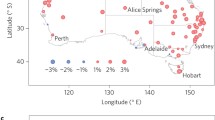Summary
The meso-scale structure of the short-term rainfall-distribution in a tropical, semi-arid area has been studied through an analysis of the correlation-distance relationship of daily rainfall data. A number of independent samples were employed. The rainfall-field has been found to be isotropic in relation to the correlation coefficient, at least within the range of 20–100 km, which reflects the relatively restricted storm motions in this area.
In general, storm cells do not occur singly at an isolated spot within the area; they develop concurrently with other cells, as part of a broader regional rainfall system. Typical distances at which storm-cells tend to develop have been identified. The distances are somewhat smaller in December and April than in other rainy months, with the average distance ranging between 40 and 60 km. Storm cells at twice that distance are also frequent.
Zusammenfassung
Es wurde die Meso-Struktur der Verteilung kurzdauernder Regenfälle in einem tropischen semiariden Gebiet durch eine Analyse der Entfernungsabhängigkeit der Korrelation zwischen täglichen Niederschlagsmengen an verschiedenen Orten untersucht. Dazu wurde eine Anzahl unabhängiger Fälle verwendet. Das Niederschlagsfeld wurde in bezug auf den Korrelationskoeffizienten als isotrop befunden, zumindest in dem Bereich von 20 bis 100 km, was die relativ beschränkten Bewegungen von Unwettern in diesem Gebiet widerspiegelt.
Im allgemeinen treten Unwetterzellen nicht einzeln an einem isolierten Platz in dem Gebiet auf; sie entwickeln sich vielmehr gleichzeitig mit anderen Zellen als Teile eines weitläufigen regionalen Niederschlagssystems. Es wurden typische Distanzen für die Neigung zur Entwicklung von Unwetterzellen festgestellt. Diese Distanzen sind im Dezember und April etwas kleiner als in anderen Regenmonaten mit durchschnittlichen Distanzen zwischen 40 und 60 km. Unwetterzellen von doppelt so großen Abständen treten ebenfalls häufig auf.
Similar content being viewed by others
References
Austin, P. M., H. B. Cochran, and G. Olu Patrick: Investigations Concerning the Internal Structure of New England Squall-Lines. Proc. 9th Weather Radar Conference, Amer. Met. Soc. and U.S. Weather Bureau, Kansas City, 193–198 (1961).
Gandin, L. S.: Objective Analysis of Meteorological Fields. Jerusalem: Isr. Prog. for Sci. Transl., 1965.
Hammer, Richard M.: Unpublished data, 1973.
Hershfield, D. M.: Rainfall Input for Hydrological Models. Symp. Geochem., Precip. Evapor., Soil-Misture, Hydrometry, Bern, 1967. Int. Assoc. Sci. Hydrol.78, 177–188 (1968).
Huff, F. A., and W. L. Shipp: Spatial Correlations of Storm, Monthly and Seasonal Precipitation. Jour. Appl. Meteor.8, 542–550 (1969).
Johnson, D. H.: Rain in East Africa. Quart. Jour. Roy. Meteor. Soc.88, 1–19 (1962).
Jackson, I. J.: Tropical Rainfall Variations over a Small Area. Jour. Hydrol.8, 99–110 (1969).
Mörth, H. T.: A Study of the Areal and Temporal Variations of Rainfall in East Africa. Proc. 4th Meeting Appl. Meteor. in East Africa, Nairobi, 1968.
Mörth, H. T.: Personal communication, 1973.
Nieuwolt, S.: The 1969/70 Rainfall Season in the Lusaka Region, Zambia. East African Geog. Rev.9, 11–24 (1971).
Owens, Jr., J. J.: Distribution of Air-Mass Thunderstorms in New England. Unpublished M. Sc. thesis, Dept. of Meteorology, Mass. Inst. Techn., Cambridge, Mass., 1966.
Sharon, D.: Spatial Analysis of Rainfall Data from Dense Networks. Int. Assoc. Sci. Hydrol., Hydrolog. Science Bulletin17, 291–300 (1972).
Sharon, D.: The Spottiness of Rainfall in a Desert Area. Jour. Hydrol.17, 161–175 (1972).
Sharon, D.: Correlation Analysis of Spatial Rainfall-Patterns in New England. Manuscript.
Stol, Ph. Th.: The Relative Efficiency of the Density of Raingage Networks. Jour. Hydrol.15, 193–208 (1972).
Author information
Authors and Affiliations
Additional information
With 6 Figures
This study was done in 1972/73, at Clark University, Worcester, Mass., U. S. A.
Rights and permissions
About this article
Cite this article
Sharon, D. The spatial pattern of convective rainfall in Sukumaland, Tanzani — A statistical analysis. Arch. Met. Geoph. Biokl. B. 22, 201–218 (1974). https://doi.org/10.1007/BF02243468
Received:
Issue Date:
DOI: https://doi.org/10.1007/BF02243468




